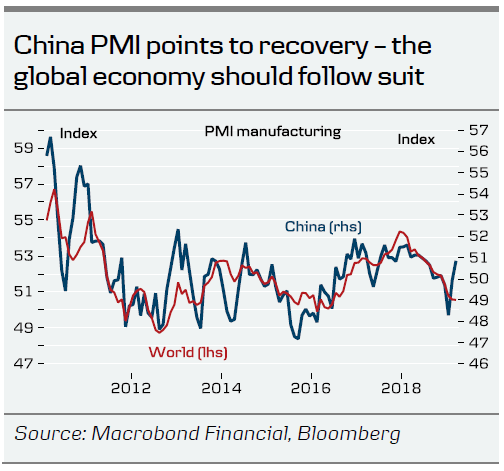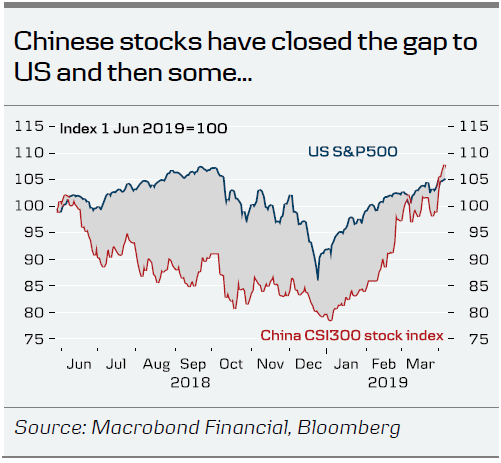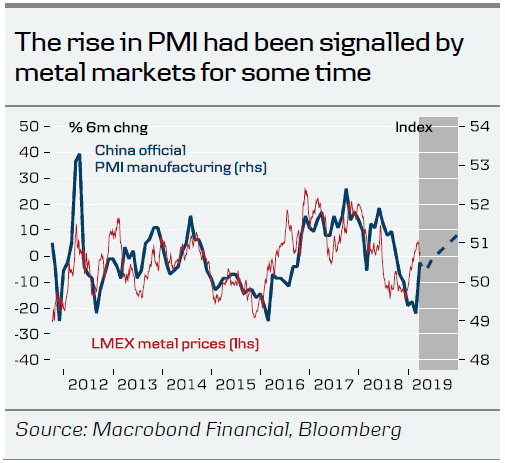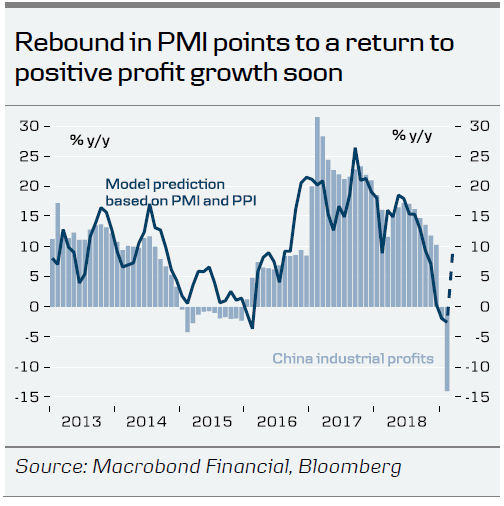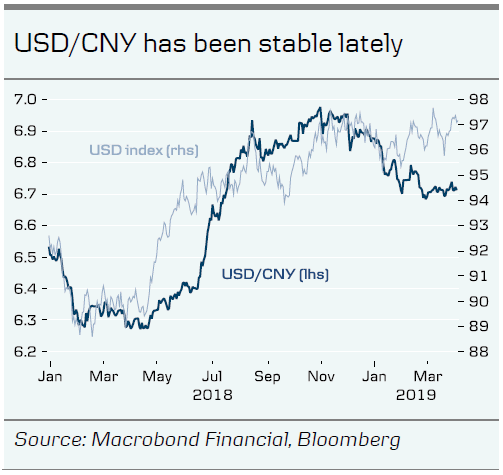- Donald Trump: US and China agree to some of the ‘toughest things’ in trade talks.
- Stronger Chinese data lead to cautious optimism.
- Trade deal or not, US and China tensions are set to continue on most other fronts.
Trade deal in sight
More progress has been made in the trade talks as we enter the ‘end-game’. However, as Trump’s trade adviser Peter Navarro said on Thursday, the last mile of a marathon is also ‘the longest and the hardest’.
High-level talks continued in Washington , with the highlight being US President Trump meeting China’s top negotiator Vice-Premier Liu He in the White House on Thursday (see CNBC , 4 April). While no announcement of a summit between Trump and China’s President Xi Jinping was announced,, the message was still one of optimism. Referring to a trade deal, Trump said ‘This is the granddaddy of them all’ and added ‘It’s got a very very good chance of happening’. He also stated that they had already agreed to some of the toughest things.
Xi has generally been much less vocal regarding the negotiations. However, an article from the Chinese news agency Xinhua on Thursday said Xi had delivered a message to Trump that substantial new progress has been made and that he encouraged the two sides to conclude the deal as soon as possible.
At a press meeting in the Oval Office, Trump praised China for delivering on its promise to clamp down on the flow of Fentanyl from China to the U.S. This was a promise made by Xi as part of the ceasefire deal on 1 December 2018 (see CNBC , 1 April).
Comment : We still believe it is more a matter of when than if we will see a trade deal. The timing is uncertain but, judging from Trump’s comments, we will have to wait another month or so for an announcement of a summit after the deal is done. One of the outstanding points is how many of the US tariffs will be lifted immediately and how many will stay on for some time.
A lot of scepticism will probably prevail after a deal with expectations that the trade war could flare up again if China fails to deliver on its promises. However, we believe China is keen to make a deal that solves the problems on a more permanent basis and will strive to meet the requirements. Stability and minimising uncertainty are key elements in Chinese policy. A deal that only puts the trade war on pause would not remove the uncertainty that is currently holding back Chinese business investments and consumer spending. This is also a reason the talks are dragging out. Both sides want to get it right the first time and avoid a flare-up of the trade war in 2020. We also doubt Trump would want to restart a trade war this side of the 2020 election, as it would be damaging for US equity markets.
More firm signs of a turn in the Chinese cycle
PMI manufacturing for March from both Caixin and official statistics surprised strongly on the upside. Both indices are now back above the 50 line. The rebound adds to the picture of a moderate recovery, as has been signalled in metal markets for some time. The details were also positive, as new orders and export orders moved higher.
The growing optimism gave another boost to Chinese stock markets, which jumped higher this week, taking the cumulative increase for the year to 35%. Chinese stocks have actually overtaken US equities if measured from when the trade war started. This is a big change from the summer months of 2018, when Trump boasted how US markets were strong while Chinese stocks declined sharply (see for example this tweet from August).
Comment: We have been looking for a bottom in Q1 in the Chinese cycle for some time and we see increasing evidence that this unfolded (see China Leading Indicators – Clearer signs of recovery, 2 April). We believe the drivers are easing on a broad range of fronts: easing trade tensions, easing monetary policy, easing fiscal policy and easing of the downward pressure from the reduction in inventories that we believe companies undertook in Q4. When strong headwinds fade at the same time as stepping harder on the gas, the economy can move forward again. We believe this is happening in China. The coming trade deal and increasing effects of the stimulus in 2018 should allow China to stage a moderate economic recovery.
The recovery in China should also spill over into a global recovery (see the chart on the front page). China has been the epicentre of the global slowdown and a rebound is set to spread to the rest of the world.
US-China tensions running high on most other fronts
While optimism is growing regarding a trade deal, the US-China tensions continue on most other fronts. On Wednesday, Vice-President Mike Pence spoke at Nato’s 70-year anniversary saying, ‘Perhaps the greatest challenge NATO will face in the coming decades is how we must all adjust to the rise of the People’s Republic of China’ (see speech). Tensions also heated up over Taiwan, as Chinese fighter jets crossed the so-called median line, fuelling a strong response from US National Security Adviser John Bolton.
Comment: We expect the US-China rivalry to continue in many areas. When it comes to trade, the two sides depend on each other. However, we believe the tech war is likely to continue, along with tensions regarding security, Taiwan, the South China Sea and China’s Belt and Road Initiative.
Other selected China news of the week
Is the US beefing up its own industrial policy in response to China? US semiconductor firms have called for more backing from Washington to stay ahead of China (see SCMP 3 April).
China has stumbled in its push to internationalise the currency. The Financial Times writes how the use of the CNY in global payments has stalled since the capital outflow crisis four years ago.
Chinese Premier Li Keqiang is heading to Europe for the EU-China summit on 9 April. This comes shortly after Xi visited Europe, meeting both French President Emmanuel Macron, German Chancellor Angela Merkel and EU President Jean-Claude Juncker.
Copying works both ways these days, with US companies looking to China for ‘inspiration’. This opinion piece in SCMP describes how Facebook looks to WeChat for ideas on developing its own digital ecosystem.




